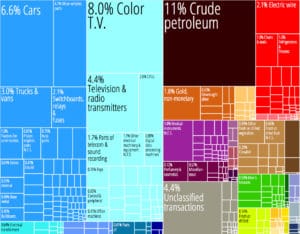
Although multiple international organizations coincide and classify Mexico as an upper middle income country, or a middle class country Mexico’s National Council for the Evaluation of Social Development Policy (CONEVAL), which is the organization in charge to measure the country’s poverty reports that a huge percentage of Mexico’s population lives in poverty.
Among the OECD countries, Mexico has the second-highest degree of economic disparity between the extremely poor and extremely rich, after Chile – although it has been falling over the last decade, being one of few countries in which this is the case.
The electronics industry of Mexico has grown enormously within the last decade. Mexico has the sixth largest electronics industry in the world after China, United States, Japan, South Korea, and Taiwan. Mexico is the second-largest exporter of electronics to the United States where it exported $71.4 billion worth of electronics in 2011. The Mexican electronics industry is dominated by the manufacture and OEM design of televisions, displays, computers, mobile phones, circuit boards, semiconductors, electronic appliances, communications equipment and LCD modules. The Mexican electronics industry grew 20% between 2010 and 2011, up from its constant growth rate of 17% between 2003 and 2009. Currently electronics represent 30% of Mexico’s exports.

Mexico produces the most automobiles of any North American nation. The industry produces technologically complex components and engages in some research and development activities. The “Big Three” (General Motors, Ford and Chrysler) have been operating in Mexico since the 1930s, while Volkswagen and Nissan built their plants in the 1960s. In Puebla alone, 70 industrial part-makers cluster around Volkswagen. In the 2010s expansion of the sector was surging. In 2014 alone, more than $10 billion in investment was committed. In September 2016 Kia motors opened a $1 billion factory in Nuevo León, with Audi also opening an assembling plant in Puebla the same year. BMW, Mercedes-Benz and Nissan currently have plants in construction.
Transportation:
The roadway network in Mexico is extensive and all areas in the country are covered by it. The roadway network in Mexico has an extent of 366,095 km (227,481 mi), of which 116,802 km (72,577 mi) are paved. Of these, 10,474 km (6,508 mi) are multi-lane expressways: 9,544 km (5,930 mi) are four-lane highways and the rest have 6 or more lanes.

Starting in the late nineteenth century, Mexico was one of the first Latin American countries to promote railway development, and the network covers 30,952 km (19,233 mi). The Secretary of Communications and Transport of Mexico proposed a high-speed rail link that will transport its passengers from Mexico City to Guadalajara, Jalisco. The train, which will travel at 300 kilometers per hour (190 miles per hour), will allow passengers to travel from Mexico City to Guadalajara in just 2 hours. The whole project was projected to cost 240 billion pesos, or about 25 billion US$ and is being paid for jointly by the Mexican government and the local private sector including the wealthiest man in the world, Mexico’s billionaire business tycoon Carlos Slim. The government of the state of Yucatán is also funding the construction of a high speed line connecting the cities of Cozumel to Mérida and Chichen Itza and Cancún.
